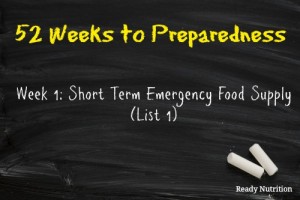 [1]
[1]Lao Tzu once said, “the journey of a thousands miles begins with a single step.” The journey to preparedness starts this way, as well. It begins with a single thought or need to want to make sure your family has everything they need to stay safe.
I know that the subject of preparedness is an overwhelming one and it can be daunting if you don’t know where to start. A few years ago, my newsletter, Get Prepped [2] sent out a preparedness program called 52-Weeks to Preparedness [3]. This online program broke down the overwhelming subject of preparedness week by week starting at the beginning of prepping for small scale disasters and moving up to longer-term disasters. Each week included supply suggestions, as well as skill sets to learn. Thousands of preppers have used this program to get their family’s ready for unexpected disasters.
I like the “slow and steady” approach to prepping because it isn’t such a budget breaker (and in this day and age, we need all the help we can get). By slowly accumulating emergency supplies, you will not feel the financial “burn” compared to having to pay for everything up front. As well, this approach removes the panic of preparing for emergencies, and in its place provides you with empowerment.
Keep in mind what type of emergencies you are planning for, if there are any family members with medical needs, how long you want your food supply to last, and so on. This will be the basis of your emergency plan and will help you make the best choices for your family.
Week 1 – Get Your Home Prepped with the Essentials
The first steps of preparedness should focus on cementing the family’s emergency plan and getting the family’s pantry prepped for a two week food supply. Ask yourself what types of emergencies you may face in the near future.
- Job loss
- Economic downturn
- Threats of natural or manmade disasters
- Concern of civil disorder
How to Start a Disaster Supply
There are a lot of events to be concerned with in these uncertain times, but once you know what to prepare for, the steps are the same. First things first, always concentrate on your basic survival needs: air, water and food. During natural and some manmade disasters, our water sources can become contaminated and it is wise to have a way to treat water.
Most families only have enough food and water for 72 hours, and in times of emergencies, we need the right food to give us adequate nutrition and energy. Therefore, since FEMA suggests that each family should have a 2 week supply of food and water for a home, this is the best place to start your preparedness supply. Being that most emergencies will knock a person off the electrical grid, you want to ensure that most of your supplies will be “off grid” compatible.
Below is a list of emergency food to purchase. This is a basic supply and we will add more to the preparedness pantry in the coming weeks. Taking time to read the nutritional information on the back of the food source and knowing other considerations [4], will help a person make the best choices for their needs. If a person needs to use their stashed food supply, having foods high in vitamins, nutrients, and proteins [5] will provide their body with what it needs for needed energy and mental clarity.
Preps to Buy:
- 1 gallon of water per day for each family member or Datrex water pouches [6] (Ensure that you have enough water for 2 weeks and remember that having more water stored up is better than being short on this essential supply).
- 2 jars of peanut butter [7]
- 2 cans of juice per family member, like this brand [8]
- 2 cans of meat per family member (tuna, salmon, chicken [9], Spam, etc.)
- 2 cans of soup [10] or stew [11] for each family member
- 3 non-perishable items such as saltine crackers [12], graham crackers [13], dry cereal [14], etc.
- 1 bag small beans (lentils [15], navy beans [16], etc.) 1 pound per family member
- 1 hand operated can opener [17]
- Permanent marker
- Additional supplies for infants or elderly – 2 weeks worth (diapers, wipes, children’s medication, formula, protein/calorie drinks, prescription medications, extra pair of glasses)
- For those who have pets: 1 large container of dry food – This amount should last 2 weeks or longer
Action Items:
- Date perishable goods with a marker
- If possible, set aside $100 to use for emergencies in small bills
- Make a disaster plan [18] and decide what types of disasters you are planning for (weather related, natural disasters, economic or personal disasters)
- Decide upon an out-of-area contact who can coordinate information with friends and family members.
- Once the out-of-area contact has been decided, email or call the newly designated emergency contact and provide phone numbers and names of family members for them to call.
This is the first step to getting prepared! Next week, we will move into basic emergency tools to have on hand. If you want to jump ahead, check out the complete 52-Weeks to Preparedness [19] List or purchase the best-selling book it was based around, The Prepper’s Blueprint [20].
